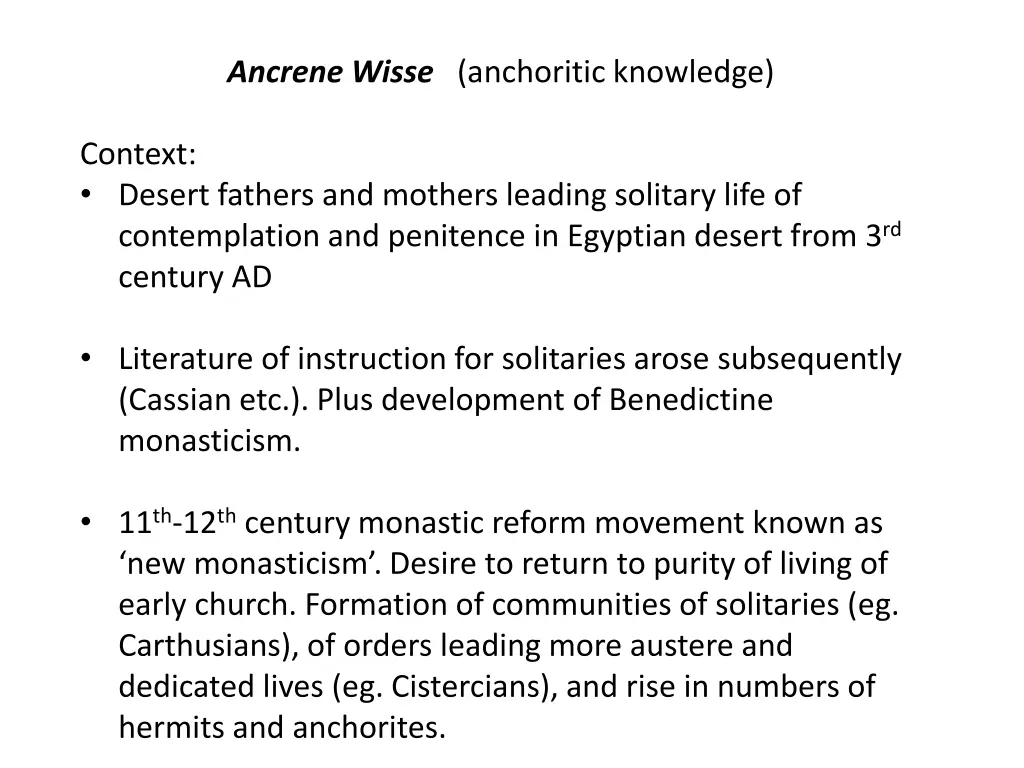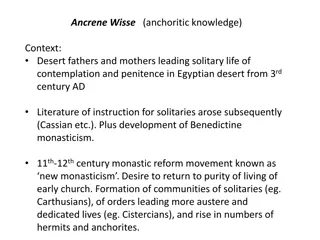
Anchoritic Knowledge and the Ancrene Wisse
Explore the profound world of anchoritic knowledge and the Ancrene Wisse, a handbook for anchoritic guidance from the 13th century. Learn about the solitude of hermits and anchorites, their enclosure rituals, and the distinctive lifestyle they led in pursuit of spiritual purity. Discover the unique insights into anchoritic communities and the influence of this medieval text on religious practices through the ages.
Download Presentation

Please find below an Image/Link to download the presentation.
The content on the website is provided AS IS for your information and personal use only. It may not be sold, licensed, or shared on other websites without obtaining consent from the author. If you encounter any issues during the download, it is possible that the publisher has removed the file from their server.
You are allowed to download the files provided on this website for personal or commercial use, subject to the condition that they are used lawfully. All files are the property of their respective owners.
The content on the website is provided AS IS for your information and personal use only. It may not be sold, licensed, or shared on other websites without obtaining consent from the author.
E N D
Presentation Transcript
Ancrene Wisse (anchoritic knowledge) Context: Desert fathers and mothers leading solitary life of contemplation and penitence in Egyptian desert from 3rd century AD Literature of instruction for solitaries arose subsequently (Cassian etc.). Plus development of Benedictine monasticism. 11th-12th century monastic reform movement known as new monasticism . Desire to return to purity of living of early church. Formation of communities of solitaries (eg. Carthusians), of orders leading more austere and dedicated lives (eg. Cistercians), and rise in numbers of hermits and anchorites.
Difference between hermits and and anchorites: enclosure. Hard for women to enter nunneries, because not many new female foundations. Not welcomed by brothers. Also expensive. Many women decided for anchoritic option instead. Entered anchorhold straight from world. Under supervision of bishop.
Enclosure ceremony conducted by bishop Enclosed in anchorhold, attached to parish church often in middle of village or town community. The anchoress perceived to die to the world, be alive only to Christ. Hence a requiem mass, prayers and psalms for the dead. Rite of extreme unction (deathbed sacrament) used. Ceremonial entry into anchorhold where open grave might be waiting. Then ritual walling up of door. Key metaphors for the anchorhold: a grave; a desert; a place of spiritual battle.
Shut away from world, but also highly visible to community Possibly several anchoresses together, plus maidservants Window toward outer world, and squint window towards body of Christ on altar inside church
Ancrene Wisse (handbook for anchoritic guidance), plus associated works (Sawles Warde, Holy Maidenhood, and 3 saints lives) All written by/for same tight group of authors and readers around north Herefordshire, around 1215-1230. Author, either Augustinian canon or Dominican. Versed in learning of Paris theological schools. Initially writing for single anchoritic community of 3 upper- class sisters. Later versions imagine larger community of 20 or more scattered women. Unique body of early Middle English prose. Nothing comparable until mid 14th century.
Widely copied and disseminated . 9 other 13th-century copies, plus translation into Anglo-Norman, and into Latin. In 13th century, mostly read by professional religious by anchoresses and nuns. One version adapted for male religious community. 14th-15th century. New versions made one with Lollard interpolations. Read by pious laity wanted to model their spiritual practice on anchoritic models. Structure of text idea of outer and inner rule of living. Outer rule (parts 1 and 8) encloses inner rule (parts 2-7)

